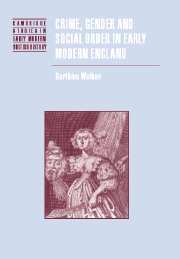Book contents
- Frontmatter
- Contents
- List of figures and tables
- Preface
- Note on quotations and dates
- List of abbreviations
- 1 Introduction
- 2 Men's non-lethal violence
- 3 Voices of feminine violence
- 4 Homicide, gender and justice
- 5 Theft and related offences
- 6 Authority, agency and law
- 7 Conclusion
- Bibliography
- Index
- Titles in the series
6 - Authority, agency and law
Published online by Cambridge University Press: 14 July 2009
- Frontmatter
- Contents
- List of figures and tables
- Preface
- Note on quotations and dates
- List of abbreviations
- 1 Introduction
- 2 Men's non-lethal violence
- 3 Voices of feminine violence
- 4 Homicide, gender and justice
- 5 Theft and related offences
- 6 Authority, agency and law
- 7 Conclusion
- Bibliography
- Index
- Titles in the series
Summary
‘Remember that authority is a touchstone which trieth every man's metal, and that justice is the summary and absolute beauty of all virtues. Abide this touch, blemish not this authority, stain not this virtue.’ Thus Cheshire magistrate Sir Richard Grosvenor in 1636 advised his son ‘in the public deportment as you stand in relation to authority, being a Justice in Commission of the Peace’. Grosvenor, a magistrate and leading member of the county elite, seemingly had a clear notion of the manner and form that authority and justice should take. But neither were rigid concepts. Both were open to interpretation. On the one hand, authority was equated with official and legal supremacy, the institution or individual in possession of the power to command and enforce obedience. On the other, in any given situation, authority might be ascribed to persons who were not in positions of formal or structural power. Authority was closely associated and invested with notions of rights and morality. Justice, too, invoked notions that complicated its relationship with judicial administration and the exercise of power. It was measured upon a scale of conformity to truth, fact and moral righteousness. These were slippery concepts. No single criterion existed whereby one might gauge the nature of justice. After all, the infliction of punishment might lead the victim of a crime and the judiciary to believe that justice had been done, yet the convicted person might not share this view.
- Type
- Chapter
- Information
- Crime, Gender and Social Order in Early Modern England , pp. 210 - 269Publisher: Cambridge University PressPrint publication year: 2003

